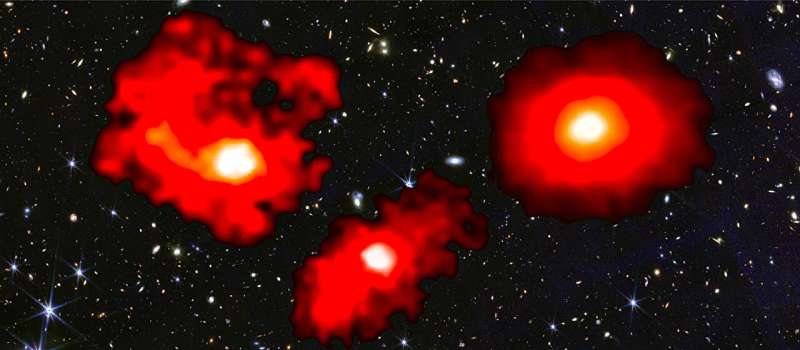
November 13, 2024 by University of Geneva
Collected at: https://phys.org/news/2024-11-discovery-galactic-red-monsters-early.html
An international team led by the University of Geneva (UNIGE) has identified three ultra-massive galaxies—nearly as massive as the Milky Way—already in place within the first billion years after the Big Bang.
This surprising discovery was made possible by the James Webb Space Telescope’s FRESCO program, which uses the NIRCam/grism spectrograph to measure accurate distances and stellar masses of galaxies. The results indicate that the formation of stars in the early universe was far more efficient than previously thought, challenging existing galaxy formation models. The study is published in Nature.
In the theoretical model favored by scientists, galaxies form gradually within large halos of dark matter. Dark matter halos capture gas (atoms and molecules) into gravitationally bound structures. Typically, only about 20% of this gas at most is converted into stars in galaxies.
However, new findings challenge this view. The researchers reveal that massive galaxies in the early universe may have been much more efficient in building stars than their later counterparts, growing much more rapidly than previously thought.
Discovery of ‘red monsters’
JWST’s unparalleled capabilities have allowed astronomers to systematically study galaxies in the very distant and early universe, providing insights into massive and dust-obscured galaxies. By analyzing galaxies in the FRESCO survey, scientists found that most sources fit existing models.
However, they also found three surprisingly massive galaxies, with stellar masses comparable to today’s Milky Way. These are forming stars nearly twice as efficiently as their lower-mass counterparts and galaxies at later times. Due to their high dust content, which gives them a distinct red appearance in JWST images, they have been named the three “red monsters.”
“Our findings are reshaping our understanding of galaxy formation in the early universe,” says Dr. Mengyuan Xiao, lead author of the new study and postdoctoral researcher in the Department of Astronomy at UNIGE Faculty of Science.
“The massive properties of these ‘red monsters’ were hardly determined before JWST, as they are optically invisible due to dust attenuation,” says Dr. David Elbaz, director of research at CEA Paris-Saclay.

A milestone in galaxy observations
The international team has developed a new program with the JWST to systematically analyze a complete sample of emission-line galaxies within the first billion years of cosmic history. This approach enabled the team to achieve precise distance estimates and reliable stellar mass measurements for the full galaxy sample.
“Our findings highlight the remarkable power of NIRCam/grism spectroscopy,” explains Pascal Oesch, associate professor in the Department of Astronomy at the UNIGE Faculty of Science, principal investigator of this observation program.
“The instrument on board the space telescope allows us to identify and study the growth of galaxies over time, and to obtain a clearer picture of how stellar mass accumulates over the course of cosmic history.”
‘Too many, too massive’ galaxies in the early universe
While these findings do not conflict with the standard cosmological model, they raise new questions for galaxy formation theories, specifically the issue of “too many, too massive” galaxies in the early universe.
Current models may need to consider unique processes that allowed certain early massive galaxies to achieve such efficient star formation and thus form very rapidly, very early in the universe. Future observations with JWST and the Atacama Large Millimeter Array (ALMA) will provide further insights into these ultra-massive red monsters and reveal larger samples of such sources.
“These results indicate that galaxies in the early universe could form stars with unexpected efficiency,” Dr. Xiao concludes. “As we study these galaxies in more depth, they will offer new insights into the conditions that shaped the universe’s earliest epochs. The red monsters are just the beginning of a new era in our exploration of the early universe.”
More information: Mengyuan Xiao, Accelerated formation of ultra-massive galaxies in the first billion years, Nature (2024). DOI: 10.1038/s41586-024-08094-5. www.nature.com/articles/s41586-024-08094-5
Journal information: Nature

Leave a Reply